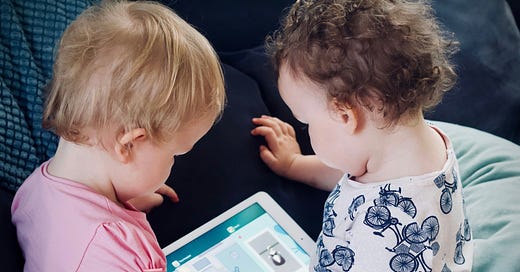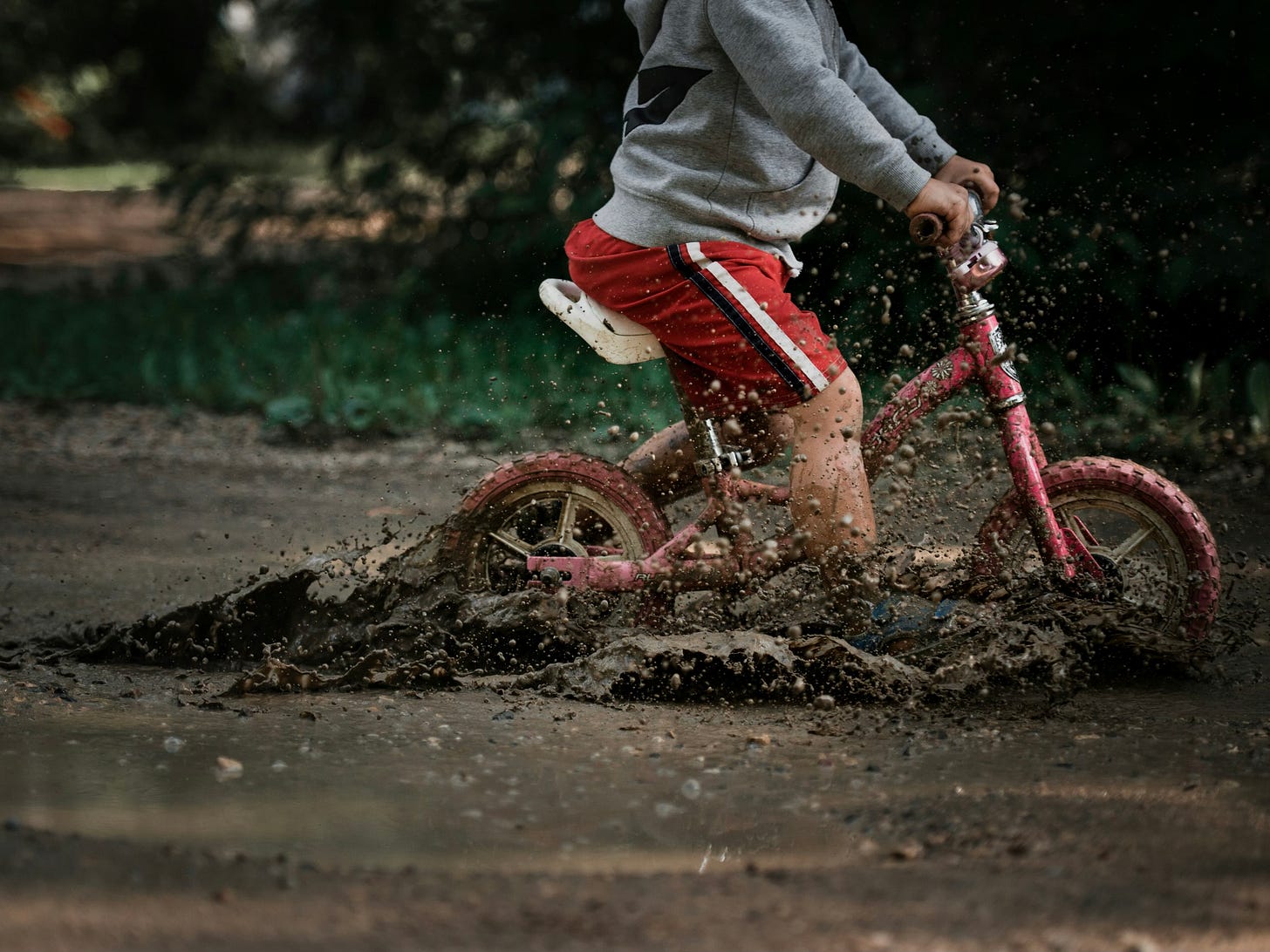Report: Young Kids Spend Far Too Much Time on Screens
A new Common Sense Media census reveals shocking statistics.
If you’re at all worried about how much time young children spend on devices, your concerns are justified. Common Sense Media has released a census on young children’s screen time habits, called “Media Use by Kids Zero to Eight.” It is the first such report since early 2020, before the pandemic, and its findings are cause for alarm.
Children aged 8 and under spend an average of 2.5 hours per day on screens. There is significant variation among different ages. Children under 2 spend one hour, three minutes a day; 2- to 4-year-olds spend two hours, eight minutes; and 5- to 8-year-olds spend a whopping 3.5 hours daily. (Keep in mind that kids under 2 are not supposed to have any screen time at all.) Boys, on average, spend 30 minutes more than girls, with significantly more time spent gaming.
Most time (60%) is spent watching TV and videos, followed by gaming (26%). Other online activities include video chatting, social networking, reading electronically, and doing homework. Gaming has surged since 2020, jumping by 65% in four years. Five- to 8-year-olds went from gaming for 40 minutes a day to just over an hour. Screens are used for emotional regulation, with nearly 1 in 4 kids using them during meals at home and 1 in 5 watching or playing on them most nights to fall asleep.
The device ownership numbers are shocking. By age two, 4 in 10 children has their own tablet, and by age four, more than half (58%) do. By age eight, nearly 1 in 4 kids (23%) has their own cellphone—and of those, 79% have a smartphone that lets them go online, download apps, and watch videos. A mere 19% have simplified smartphones with limited Internet accessibility (like Bark, Troomi, Gabb, or Pinwheel phones), and only 3% have simple phones without touch screens or online capabilities.
Short-form videos are growing in popularity, viewed on platforms like TikTok, YouTube Shorts, and Instagram Reels. Common Sense Media says these platforms “are not designed for children and focus on quick, bite-sized videos”; and yet, under-8s spend 14 minutes per day on average on them. Socio-economic differences emerged as well, with children from lower-income families spending 24 minutes daily on short-form videos, compared to 7 minutes among children from higher-income families.
What Are Parents Thinking?
Parental attitudes toward screen media are fickle and fascinating. Most are concerned about negative effects, with 80% fearing their child spends too much time on a device; 79% worrying about the impact on attention span; 76% and 75% concerned about exposure to sexual and violent content, respectively; and 75% fearing the impact on mental health.
And yet, nearly three-quarters of parents cite enthusiasm for screen-based media’s potential for teaching new things, showing “positive depictions, e.g., acts of kindness, helping, or love,” sparking new interests, connecting with family and friends, and “being exposed to different people, places, and cultures.”
The disconnect between those two contradictory attitudes is jolting to an outside observer. Yes, plenty of wonderful things do exist online, but all of those beneficial things can also be found offline, particularly by a young child. Why pursue them in a screen-based environment that’s rife with dark, overly mature content and designed for compulsive use? I am struck by parents’ willingness to overlook the significant negatives in favour of, what? An easy, portable babysitter?
The Wrong Tools
I have spent the past 15 years raising three little boys, so I am sympathetic to the challenges of keeping young children entertained. It is often difficult, whether you’re trying to keep them quiet and calm in public or frantically preparing dinner for a hungry family. And sometimes you just really need a break.
But parents are seeking relief in the wrong places. A tablet, smartphone, or gaming console is not a babysitter. To quote Jonathan Haidt, “It’s an experience blocker that leads to increasing levels of addiction and stunted growth.” That’s not how we should keep our kids entertained, no matter how busy, tired, or stressed we might feel.
One of the basic mottos of my book, Childhood Unplugged, is “Begin as you mean to go on.” There is no easier time to be screen-free than during those early years of zero to eight. Children don’t yet know what they’re missing. You, as the parent, can establish the “norms” of your own household, and your child will accept them readily, even if they start to perceive that things are done differently elsewhere.
I recall my little boys going to play at other kids’ houses, where they would watch animated shows on large-screen TVs. They loved it, talked about how amazing it was, but it never occurred to them to ask for it at home. It was just something that happened elsewhere, and that was that. At these young ages, it is far easier not to introduce devices at all than to have to claw them back later, once use gets out of control (which it will, inevitably).
Real-Life Thrills
One of the most delightful things about young children is their fascination with the world. Everything is new and ripe for exploration. Whether it’s a stick and a puddle, a cardboard box, the Tupperware drawer, a log on a trail, a pile of rocks, a set of building blocks, a sheet of blank paper with fingerpaints, or even a great story, a child can be entertained for long minutes, even hours. They will observe, feel, test, handle things with determination, learning from the physical and emotional feedback they receive, forming a clearer picture and better understanding of this exciting place they inhabit.
But when parents offer screens instead, they condition the child to crave a form of hyperstimulating entertainment that no natural, physical, open-ended plaything can rival. The real world pales in comparison to the flashy, noisy, thrilling lure of screen-based play; it becomes boring. The child begs for the device, and the cycle perpetuates.
While distraction may be instantaneous when a screen is handed over, it ends up making the parent’s job harder in the long run. Because the device is so neurologically stimulating, it becomes difficult for the child to “come down” once their time is up, and tantrums are likely to ensue. The device does not resolve distraction, but rather postpones the inevitable moment of having to come face-to-face with boredom. Furthermore, it prevents the child from learning how to cope with empty moments and learn how to entertain themselves with whatever analog toys are at hand.
Ditch the Devices
If you count yourself among the 80% of parents who think their young child spends too much time on a device, I have a radical suggestion for you: Get rid of it. These are not things to be “managed.” It’s far better not to expose your child at all to the irresistible lure of a device that will make the rest of life seem dull, and that threatens to degrade your family life into a constant battle over screen time.
You could have a smashing ceremony, which sounds dramatic, but it works. I have a friend whose 9-year-old son was struggling with a tablet addiction. The father tried time limits, parental controls, and confiscating the device, but ultimately, the two took a hammer to the tablet in the backyard. That was four months ago, and the son has never asked for it back, because he knows it doesn’t exist.
When you ditch the screen-based play, you will need to go through what Melanie Hempe of ScreenStrong has described as the “replacement phase,” when digital toys are replaced with physical, analog ones. This takes time, patience, and involvement by the parent, particularly if the child has never developed the skills to entertain themselves and play in the real world. But give it time, and the child will adapt.
Stock your home with interesting, open-ended, loose-part toys, craft supplies, building materials, and more. Seek out the toys that you enjoyed as a child; kids’ interests have not changed that much in a single generation. Find likeminded families and neighbours who want to get their kids off screens, too, and set up play dates. Prioritize outdoor play; nature is a powerful tool for calming kids down, teaching them, and delighting them. Go to the library regularly and get fresh reading material. Make time for reading each day, and model it yourself.
Get comfortable with boredom. Your child does not need to be entertained every minute of the day, and if they’re struggling, tell them it’s a sign that creative inspiration is just around the corner, about to strike! Let them be, and they will find things to do. Kids are marvellously adept at entertaining themselves, given the chance to do so.
I can only hope that the next version of this Common Sense census, in another four years’ time, will reveal a decrease in screen time for young kids. This is such a fleeting and critical period during which behavioural patterns are created and habits are established. Kids of all ages, but especially young ones, do not need screen-based entertainment. As a parent, you have the right to demand a higher-quality childhood for your kid than one steeped in Internet culture. You can say no.
You Might Also Like:
Have You Read My Book?
Childhood Unplugged: Practical Advice to Get Kids Off Screens and Find Balance is available in paperback, PDF, or audiobook. If you love it, as many other readers have (it’s got a 4.9-star rating!), consider leaving a review on Amazon, which my publisher tells me is a huge help for boosting sales and visibility. If you’d like to learn more about my work, please check out my website.
A Small Reminder:
I am able to write this newsletter twice a week and keep it open to the general public, thanks to generous readers who enjoy my words enough to sign up for a paid subscription! It’s entirely a labour of love and it takes a LOT of time and effort to do. Paid subscribers are a sign that I’m on the right track.






Katherine, as a fellow boy mom (ages 3 and 7) I appreciate all of your writing and practical suggestions! It can feel lonely out here as a low-tech parent. Completely agree about never introducing the tablet. Our go tos: set up a digging pit in the backyard, let the boys use real tools, ride lots of bikes, climb high walls/trees, use walkie talkies, etc. There's more boo boos, more mess, and more noise. Also a great suggestion from Dr. Meghan Owenz: go back to physical media. We borrow audiobooks on CD from the library or old DVDs (think Reading Rainbow) and let the boys put them in an old CD player. But like the other commenter, I worry about whether my boys will have peers or partners in their 20s and 30s that can navigate these times...
This is SO important, YES!! As a Montessori educator for 30+ years, a fellow parent, and head of school watching children from birth to adolescence developing themselves in all areas, I cannot stress enough how SIMPLE and crucial it is (and easier as you point out well in your book and Substack articles) it is to raise children WITHOUT these devices. Just smash them, yes! And save a child’s life from the misery of missing out on this beautiful world.